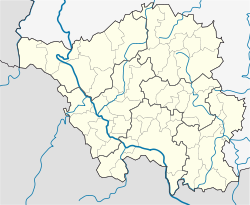Gersheim is a municipality in the Saarpfalz district, in Saarland, Germany. In its southwest it borders the french region Grand Est. Gersheim is located approx. 15 km southwest of Zweibrücken, and 20 km southeast of Saarbrücken.
Gersheim | |
|---|---|
Location of Gersheim within Saarpfalz district  | |
| Coordinates: 49°8′N 7°12′E / 49.133°N 7.200°E | |
| Country | Germany |
| State | Saarland |
| District | Saarpfalz |
| Government | |
| • Mayor (2019–29) | Michael Clivot[1] (SPD) |
| Area | |
| • Total | 57.48 km2 (22.19 sq mi) |
| Elevation | 233 m (764 ft) |
| Population (2022-12-31)[2] | |
| • Total | 6,329 |
| • Density | 110/km2 (290/sq mi) |
| Time zone | UTC+01:00 (CET) |
| • Summer (DST) | UTC+02:00 (CEST) |
| Postal codes | 66451–66453 |
| Dialling codes | 06843 and 06844 |
| Vehicle registration | HOM |
| Website | www.gersheim.de |
Settlements
editThe municipality (Gemeinde Gersheim) consists of the villages
- Gersheim
- Bliesdalheim
- Herbitzheim
- Rubenheim
- Walsheim
- Medelsheim
- Seyweiler
- Niedergailbach
- Peppenkum
- Utweiler
History
editThe oldest known traces of human settlement are celtic tumuli on several hilltops.
The gaul tribe of the Mediomatrici had its main settlement in this region at the site of modern town of Metz. Notable mediomatician findings can be seen at the European Archaeological Park of Bliesbruck-Reinheim.
Gaul later became part of the Roman Empire. After the fall of the empire in the Migration Period the area was occupied by frankish tribes. The name ending 'heim' of most of the villages hints that they might be founded in the early medivian, merovingian era.
Under changing lokal noble rulers the villages became part of Lotharingia, Burgund and the Spanish Netherlands over the medevial centuries.
The devastation of the Thirty Years' War almost completely depopulated the whole region, so new settlers from the alpine countries were relocated to the North. This led to long lasting bonds like the annual fair 'Kleintiroler Weiherfest' (see Tirol) in Rubenheim.
With the French Revolutionary Wars the area became part of the French Empire. With the Congress of Vienna the villages were handed over to the bavarian Kingdom and as part of the Rhenish Palatinate they became the very western border of Bavaria until the year 1946.
After World War II the region was occupied by France and kept as semi-independant Saar Protectorate until, after a referendum, it became a state of Western Germany in 1956.
The village Gersheim itself was first officially mentioned under the name 'Geroldesheim' in the year 1150.
The municipality Gemeinde Gersheim was founded by dissolving and reorganising several neighboring communities as part of a administrative reform in 1975.
Geography
editThe municipaly has a size of 57,4 square kilometer. The area consists of low hills up to 400m above sea level. Most of the ground is Muschelkalk aside of a small sandstone area east of Bliesdalheim.
The most notable water body is the river Blies.
Gersheim borders the municipalities Mandelbachtal in the northwest and Blieskastel in the northeast and east.
Parts of the area are restricted in use or access for environmental reasons as Gersheim became part of the UNESCO Biosphere Reserve Bliesgau in 2009.
Economy
editGersheim is mostly a Bedroom community. This has some tradition as many men from the villages over the last centuries travelled to the industrial centres of the Saarland on a daily basis to work mainly as coal miners (Kumpel) or steel workers.
Business in Gersheim decreased noticably since the 1980s as e. g. the number of farmers reduced and industrial enterprises like chalk mining and cement production ended. The lokal railway line 'Bliestalbahn' was closed end of the 1990s.
Gersheim approaches soft tourism to counter this, using the status within the UNESCO biosphere area. Around the Gersheim village itself, guided tours to see rare orchids are offered.
References
edit- ^ Gewählte Ober-/Bürgermeister*innen, Landrät*innen und Regionalverbandsdirektor*in im Saarland, Statistisches Amt des Saarlandes, 27 March 2022.
- ^ "Fläche und Bevölkerung - Stand: 31.12.2022 (Basis Zensus 2011)" (PDF) (in German). Statistisches Amt des Saarlandes. June 2023.


